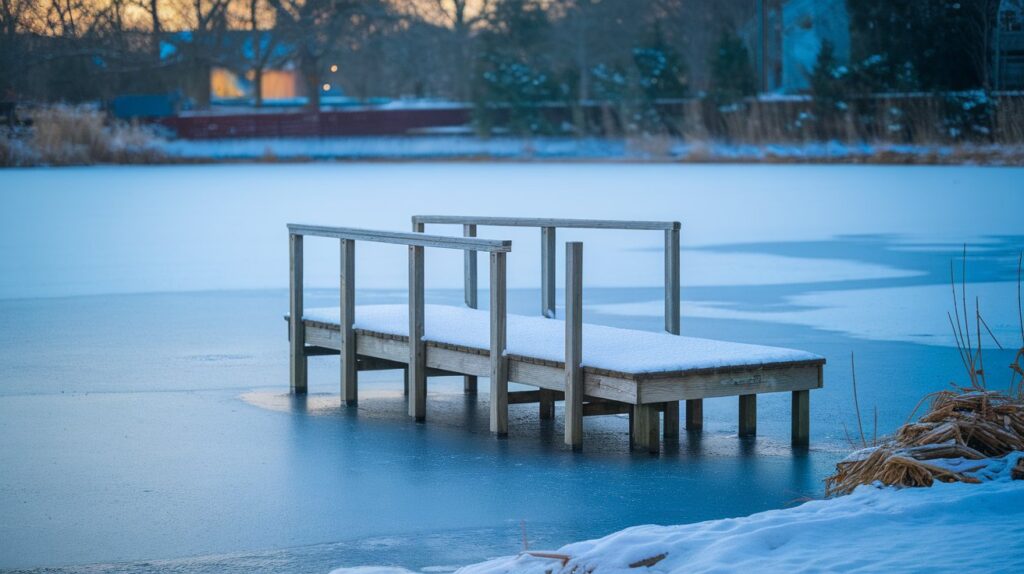That first hard freeze is a beautiful sight in Canada, but for pond owners, it signals a season of hidden danger. Beneath the serene layer of ice, a silent crisis can be unfolding.
As oxygen drops and toxic gases mount, your pond becomes a ticking time bomb. We’ve all seen the heartbreaking result in spring: dead fish and an algae-choked mess. But this doesn’t have to be your annual reality.
This guide gives you straightforward strategies to fight back, focusing on how proper aeration can be the simple fix that saves your pond.
Why Winter Poses Serious Risks to Canadian Ponds
Beneath that serene icy surface, your pond is fighting for its life. The formation of continuous ice cover creates a sealed environment where natural gas exchange with the atmosphere ceases.
This simple physical barrier triggers a cascade of potentially devastating ecological consequences that every pond owner should understand.
That beautiful sheet of ice on your Ontario pond is a liar. Underneath, a crisis is brewing. Decaying leaves and plants are actively consuming oxygen and releasing toxic gases.
Trapped by the ice, this poisonous air has nowhere to go. The devastating result is often a springtime fish kill, a silent disaster you discover when it’s far too late to help.
The Most Common Winter Problem Scenarios
Pond owners often discover these problems too late.
- Oxygen depletion: Aquatic life and decomposing matter continuously consume available oxygen
- Carbon dioxide buildup: Trapped gases create toxic conditions for fish and beneficial bacteria
- Nutrient accumulation: Decomposing organic matter releases phosphorus and nitrogen that fuel spring algae blooms
- Ice cap pressure: Solid ice coverage prevents natural gas exchange with the atmosphere
The Critical Role of Aeration in Preventing Winter Pond Problems
That frozen surface is literally suffocating your pond. An aeration system fights back by punching breathing holes in the ice. It’s a simple, powerful solution: it vents the dangerous gases building up underneath and pulls fresh oxygen back in, all winter long.
How Aeration Fights Winter’s Grip
Here’s the simple genius of it: an aerator churns the water just enough to stop a solid freeze. That small, open patch becomes your pond’s lifeline. It lets the bad air out and the good air in, performing the essential breathing that the ice prevents.
For pond owners facing a Canadian winter, this is a fundamental insurance. Without it, you’re risking the entire health of your aquatic ecosystem.
Why Professionals Rely on Aeration
What’s the expert’s secret for winter survival? Consistent aeration. The pros at Pond Perfections, a trusted pond store located in Ontario, see it firsthand: a well-set-up system keeps oxygen at a healthy 80-90% saturation, fighting back against the ice’s suffocating grip.
The payoff is clear:
- Drastically improved fish survival
- Preservation of beneficial bacteria
- Prevention of major spring algae blooms
This process directly fights the slow suffocation of winter. If you do one thing to protect your pond, it should be this: install a proper aeration system. Your spring self will thank you for it.
Installing the Right Aeration System for Canadian Winters
In our climate, you need gear built for the cold. Prioritize systems with cold-rated components that won’t fail in deep freeze. The main goal is to create and maintain an open water area-this is your pond’s vital breathing hole all winter long.
You’re essentially choosing between two proven strategies for keeping the ice at bay:
Floating Fountain Systems
These units agitate the surface water, using constant movement to prevent a solid ice seal from forming.
Bottom-Based Diffused Aeration
This method pushes air from the pond’s bottom, creating powerful updrafts that bring warmer water to the surface to melt openings in the ice.
Critical Installation Considerations for Winter Systems
Here are the essential factors to consider when installing your winter systems:
- Placement position to maximize water circulation patterns
- Ice protection measures to prevent equipment damage during freeze-thaw cycles
- Proper sizing based on pond volume and surface area
- Accessibility for winter monitoring and maintenance
- Backup power options for critical systems during outages
Creating Your Comprehensive Winter Protection Plan
A healthy pond in spring isn’t luck-it’s the result of a well-timed game plan. Throwing products at the problem last minute rarely works. Your best defence is a strategic schedule that guides you from late summer right through to the spring thaw.
Your Seasonal Pond Care Calendar
Think of this as your essential winter prep checklist. Timing is everything.
- Late August – September: Start with a pond health check. Test your water and note any weed growth or vulnerabilities.
- September – October: Service your aeration system. This is the window to install new equipment before the cold sets in.
- Late October – November: Apply final treatments and clear out leaves and debris. Don’t let decaying organic matter poison your pond all winter.
- December – February: Stay vigilant. Regularly check that your aerator is maintaining an open water area.
- March – April: Assess the winter’s impact and prepare for spring startup.
A crucial note on timing: Your location dictates your schedule. If you’re in British Columbia, you might push tasks into November. But if you’re facing a Prairie or Quebec winter, aim to have everything wrapped up by mid-October.
Don’t Gamble With Your Pond This Winter
Don’t leave your pond’s health to chance against a Canadian winter. Get a proper aeration system early. By focusing on a solid aeration setup now, you’re giving your pond a fighting chance. You’ll be amazed at the difference it makes when the ice finally melts.
For personalized guidance on winter pond protection strategies specific to your region and pond characteristics, consult the experts at Pond Perfections, your pond and lakeshore specialists.

